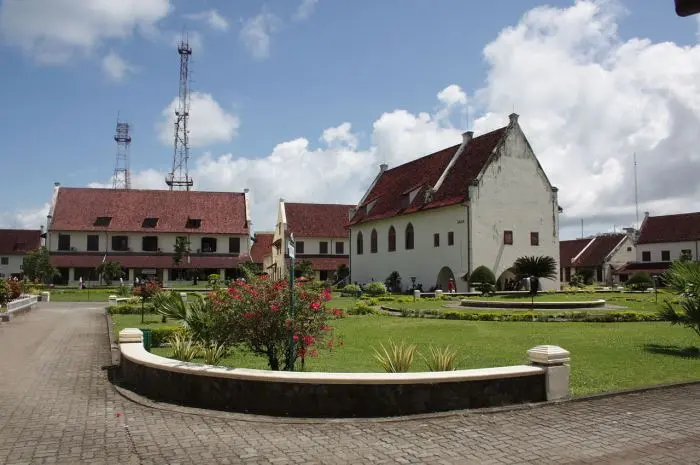Nestled in the bustling city of Makassar, Indonesia, Fort Rotterdam stands as a testament to the rich and turbulent history of the region. This iconic fortress, known for its distinctive architecture and significant historical value, has become a major tourist destination.
Visitors from around the world are drawn to its well-preserved structures, captivating museums, and the stories that echo through its ancient walls. This article explores the historical significance, architectural beauty, and visitor experiences that make Fort Rotterdam a must-visit destination in Makassar.
Historical Significance
1. Origins and Construction
Fort Rotterdam, originally known as Benteng Ujung Pandang, was constructed in 1545 by the 9th Sultan of Gowa, I Manrigau Daeng Bonto Karaeng Lakiung Tumapa’risi’ Kallonna.
The fort was initially built using simple materials like clay and coconut fibers, which were later replaced with stronger materials such as stone and coral during subsequent renovations. The structure was designed to protect the Gowa Sultanate from naval invasions and played a crucial role in the defense of Makassar.
2. Dutch Colonial Era
In 1667, following the defeat of the Gowa Sultanate in the Makassar War, the fort was captured by the Dutch East India Company (VOC). It was renamed Fort Rotterdam after the Dutch city of Rotterdam.
The Dutch extensively rebuilt and expanded the fort, giving it the distinct European architectural style that can still be seen today. Fort Rotterdam became the headquarters of the VOC in Sulawesi and served as a center for administration, military, and trade activities.
3. Cultural and Political Importance
Throughout its history, Fort Rotterdam has been a site of significant cultural and political events.
It served as a place of exile for notable figures, including Prince Diponegoro, a Javanese nobleman who led a rebellion against Dutch colonial rule in the early 19th century. The fort also played a role in various uprisings and movements during Indonesia’s struggle for independence.
Architectural Beauty
1. Design and Layout
Fort Rotterdam’s design reflects a blend of European and indigenous architectural influences. The layout of the fort resembles a turtle, which is believed to symbolize strength and resilience.
The walls and bastions of the fort are constructed from coral and limestone, giving it a unique texture and appearance. The fort is surrounded by a moat, adding to its defensive capabilities.
2. Notable Structures
- Bastions: The fort features several bastions, each named after Dutch figures. These bastions provided strategic vantage points for surveillance and defense.
- Main Gate: The main gate of Fort Rotterdam, with its imposing structure and Dutch-style gables, serves as a grand entrance to the complex.
- Buildings and Barracks: Inside the fort, visitors can explore various buildings and barracks that once housed soldiers, administrators, and prisoners. These structures have been meticulously preserved and restored.
- Church of Saint Nicholas: One of the oldest buildings within the fort, this church was used by Dutch soldiers and officers for religious services.
Museums and Exhibits
Fort Rotterdam is home to two significant museums that offer visitors a deeper understanding of the region’s history and culture.
1. La Galigo Museum
The La Galigo Museum, located within the fort, houses an extensive collection of artifacts related to South Sulawesi’s history, culture, and maritime heritage. The museum is named after the La Galigo epic, a monumental piece of literature from the Bugis culture.
- Exhibits: The museum’s exhibits include traditional Bugis and Makassar clothing, weapons, pottery, musical instruments, and maritime artifacts. One of the highlights is the display of ancient manuscripts and inscriptions that provide insights into the region’s historical and cultural development.
- Cultural Insights: Visitors can learn about the traditional lifestyles, rituals, and customs of the Bugis, Makassar, and Toraja people through the well-curated exhibits.
2. Museum Negeri La Galigo
This state museum, also located within the fort, offers a broader view of the historical and cultural evolution of South Sulawesi. The museum’s displays cover various aspects of the region’s history, including prehistoric times, the rise and fall of kingdoms, colonial history, and the struggle for independence.
Visitor Experience
1. Guided Tours
Fort Rotterdam offers guided tours that provide an in-depth look at the historical and cultural significance of the site. Knowledgeable guides share fascinating stories and historical facts, enhancing the visitor experience. These tours are available in multiple languages to cater to international tourists.
2. Cultural Performances
The fort occasionally hosts cultural performances, including traditional dances, music, and theatrical presentations. These events offer visitors a chance to experience the vibrant culture of South Sulawesi firsthand.
3. Educational Programs
Fort Rotterdam is also a hub for educational programs and workshops. These programs are designed to educate both locals and tourists about the rich history and heritage of Makassar and South Sulawesi.
4. Photography Opportunities
The picturesque setting of Fort Rotterdam, with its well-preserved buildings, scenic moat, and lush gardens, makes it a popular spot for photography. Visitors can capture stunning images of the historical architecture and scenic views of the surrounding area.
Conclusion
Fort Rotterdam stands as a remarkable historical and cultural landmark in Makassar, offering a unique glimpse into the region’s past. Its well-preserved architecture, fascinating museums, and engaging visitor experiences make it a must-visit destination for anyone traveling to Makassar.
Whether you are a history buff, a cultural enthusiast, or simply looking to explore the beauty of South Sulawesi, Somba Opu Fort promises an enriching and memorable experience.
As you walk through its ancient corridors and explore its storied past, you’ll gain a deeper appreciation for the historical tapestry that shapes the vibrant city of Makassar today.







